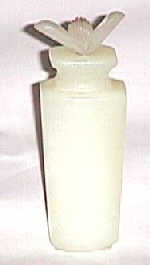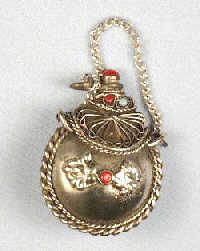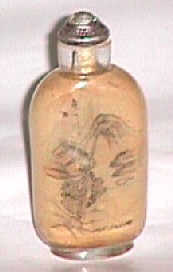| Art Q&A > Crafts |
|
|
Chinese Snuff Bottles The art of the snuff bottle occupies an important position in the history of arts and crafts of both China and the world. From the time it appeared up to now, the snuff bottle has been treasured and collected. The snuff bottle presents an embodiment of many arts and crafts such as drawing, calligraphy, carving, inlaying, painting, which open up a new form of comprehensive arts and crafts, have become a miniature of prosperity and development of arts and crafts in ancient China. Its small, exquisite and diversified forms, varied decorations and rich content of its designs combine to form a unique image of art, producing magical charm.
It is commonly believed that the snuff bottles were introduced into China by the western missionaries. The earliest reference of snuff bottles into China was dated 1684. The missionaries Johannes Gabiani and Johannes Valat greeted Emperor Kangxi and presented the emperor with four European manufactures. The emperor returned all items to the missionaries for their own uses except for the snuff bottles. However, the snuff bottles in China actually emerged far earlier than 1684. The western snuff bottles were not suitable for the humid weather in China. As the snuff bottles were getting popular in China, the Chinese soon produced snuff bottles more suitable for the Chinese climates. The snuff bottles were being made in great quantity by the Imperial Workshops in around 1700. Still, there are many valuable collections made by the snuff bottle collector's communities.
Many of the precious stone and mineral snuff bottles existing today were made by the Imperial Household Department of the Qing Dynasty. The stones often have a hardness of 6 or 7 out of the moh scale. The stones had to be carved into the shapes of the bottles and decorated on the outside. The inside of the snuff bottles also had to be dug out through the mouth of the bottle. During the Qing Dynasty, there was no electricity or any technology to perform such task other than human skill. The way it was done is considered as virtually impossible today. 2. Metal Snuff Bottles There are two main types of metal snuff bottles that exist today. One is with a silver body, commonly inlaid with precious stones or bearing decorated motifs depicting the eight trigrams or celestial stems and terrestrial branches. Another is with a copper body, and makes up the majority. Most of the copper snuff bottles are of painted enamel type. Black was the most favored color for the background. Most of the pictures on metal snuff bottles were based on traditional Chinese painting of birds and flowers.
3. Glass Snuff Bottles The majority of Chinese glass bottles were made by craftsmen from Shandong and Guangdong providences and western missionary artists. Overlay techniques were used intensively on glass snuff bottles.
A considerable number of glass painted enamel snuff bottles from the reign of Qianlong exist today. These pieces are known as "Guyuexuan". The glass bodies were made in two types - opaque white and translucent. 5. Inside Painted Snuff Bottles The great innovation by the Chinese in producing glass snuff bottles was the invention of inside painting. Inside painted snuff bottles were also sometimes made of rock crystal and amber. 6. Porcelain Snuff Bottles The porcelain snuff bottles were made in a great variety of shapes, resembling corncobs and lotus flowers, or in double-layered openwork designs. |
||||||||
All rights reserved. Reproduction of text for non-commercial purposes is permitted provided that both the source and author are acknowledged and a notifying email is sent to us. |
||||||||
 |
 History
History
 Types
Types


